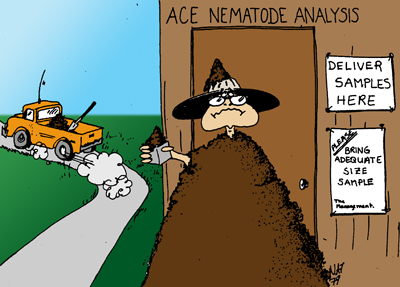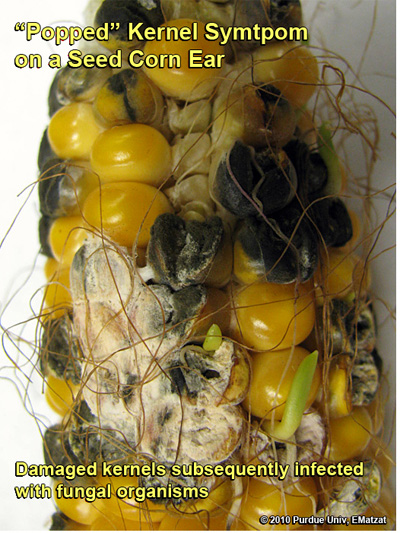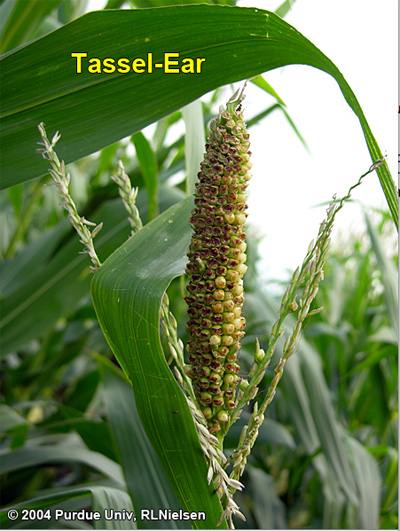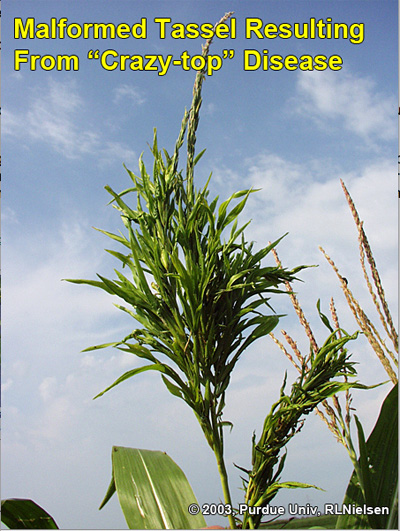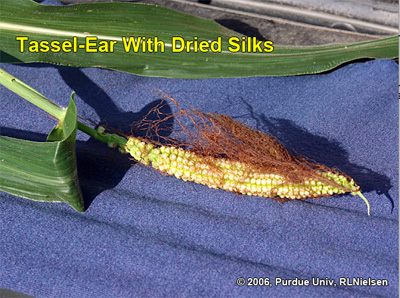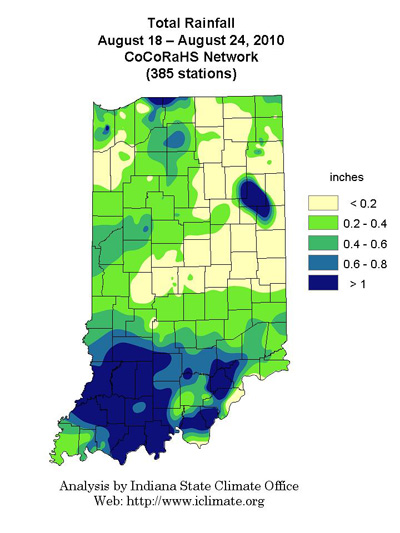Pest & Crop Newsletter, Entomology Extension, Purdue University
- VIDEO: Nematode Updates
- VIDEO: Western Bean Cutworm, A Tale of Two Differently Treated Fields
- Black Light Trap Catch Report
Nematode Updates - (Jamal Faghihi, Kiersten Wise, Christian Krupke and Virginia Ferris)
Soybean Cyst Nematode: Soybean Cyst Nematode (SCN) continues to be a problem in soybeans. The SCN symptoms usually appear as patches of yellow and stunted soybeans. We observed numerous fields with these symptoms throughout the state this year. The white and yellow female bodies, which form the cysts when they die, should be visible on the soybean roots. To see these cysts, dig the soybean plants out of the ground with a shovel and dip in a bucket of water to observe the new cysts. Care must be taken when digging the plants as the cysts are loosely attached to the soybean roots. Locating the young cysts on the roots is especially important in resistant soybeans, as this is the best indicator of their true resistance.
We have been warning you in our previous articles that the field populations of SCN in Indiana are changing in ways that render the most common source of resistance to SCN (PI88788) less effective. Other researchers in the region have reported similar trends. In the past three years the North Central Soybean Research Program (NCSRP) has funded a collaborative regional project throughout the Midwest to establish large field plots in areas where the PI88788 type of resistance is no longer effective. The Indiana plots are planted with commercial soybean cultivars with PI88788, Peking and CystX® sources of resistance along with a susceptible cultivar. Last year we noticed significantly higher yields from plots where the source of resistance was effective. This year, visual symptoms from these plots are indicative of the effectiveness of their particular sources of resistance. The two cultivars with either the Peking or CystX® sources of resistance have no sign of SCN symptoms and the plants look healthy. However, the cultivar with the PI88788 source of resistance and the susceptible cultivar are showing typical SCN symptoms. We have also noticed the occurrence of Sudden Death Syndrome (SDS) in many of the SCN infested fields. Even though SDS symptoms are not caused by the SCN, the SDS severity is magnified when SCN is present in the soil. The severity of the SDS symptoms is more pronounced when the source of SCN resistance is no longer effective. The susceptible cultivar and the ineffective PI88788 cultivar consistently show severe SDS symptoms throughout our NCSRP plots in northern Indiana (Figures 1 and 2).
We continue to emphasize the importance of soil tests as the only accurate way to know whether the numbers of SCN are changing and whether a resistant variety is still working. Growers need to understand that genetic shifts in SCN populations are gradual and they should not wait for obvious yield losses before determining that a change in the SCN population has occurred. If genetic determination (HG-type or race test) has been performed for a field population in the past, you might want to repeat the test after about four soybean crops to measure any possible changes. If no genetic profile exists for a field, one must be established so future comparisons are possible. In other words, simply planting SCN varieties said to be resistant is not the final solution to the SCN problem, and areas with high levels of both SDS and SCN need to managed accordingly. The management of this highly adaptable pest is an ongoing and dynamic situation that requires constant vigilance.
The best way to manage SCN over the years is to monitor your populations by sampling each field at least every four years. In fields with a history of SCN and SDS, growers should select varieties that have resistance to both the disease and nematode. You can sample the soil anytime of the year and get an accurate understanding of the cyst population. This is a very crucial step in SCN management and should not be neglected. We provide this service to soybean growers at the cost of $10/sample, for which the submitter will receive a bill unless we are instructed otherwise. For more information on other services that we provide you may visit our Nematology website: <http://www.entm.purdue.edu/nematology/>
If you have any questions about plant parasitic nematodes, you can contact Jamal Faghihi at 765-494-5901 or send an email to jamal@purdue.edu. Soil samples for nematode analysis can be sent to: Nematology laboratory, Purdue University, Department of Entomology, Smith Hall, 901 W. State Street, West Lafayette, IN 47907-2089.
Figure 1. Commercial soybean cultivars labeled with their sources of SCN resistance
Figure 2. A soybean plot from northern Indiana showing symptoms of SCN and SDS
![]()
VIDEO: Western Bean Cutworm, A Tale of Two Differently Treated Fields - (Christian Krupke and John Obermeyer)
One critical and often-neglected aspect of IPM is the evaluation stage. We (researchers included) often assume that applying a labeled insecticide at the recommended rate will solve a particular pest problem. This isn’t always the case. The video below examines two fields in northern Indiana that exceeded the treatment threshold for western bean cutworm. Both were treated with insecticide, but due to the timing of the treatment, the results were very different. Watch the following video for more specifics:
![]()
![]()
Click here to view the Black Light Trap Catch Report
Popped Kernels and Silk Cut – (Bob Nielsen)
Among a number of corny oddities that appear from time to time is one that falls into the “kernel disorder” category. A crop consultant once reported on the occurrence of a symptom in a seed corn production field known as “popped kernels”. In his words, “...the kernels appear diagonally sliced. Each sliced half is then folded back exposing the endosperm, which later receives the fungal attack.”
The popped kernel symptom and the related “silk-cut” symptom are indeed corny oddities in that they rarely occur in commercial hybrids in Indiana and occasionally occur at significant levels in seed corn inbreds. Unfortunately, when the symptoms do occur, they predispose the affected kernels to attack by ear-rotting fungal organisms.
The causes are unknown, but are believed to be related to stressful conditions following pollination. A report from Texas, for example, suggests that the silk-cut symptom occurs quite frequently in areas of south Texas prone to late-season drought stress (Odvody et al., 1997).
The Compendium of Corn Diseases (White, 1999) describes these two phenomenon quite well and I quote:
“Popped kernel and silk-cut, although common in breeders’ nurseries, are rarely seen on commercial hybrids. It is assumed that this characteristic is inherited, and it is usually eliminated during the breeding and selection process. Popped kernel is an irregular break in the seed coat over the kernel crown. The kernel resembles a partially expanded popcorn kernel. This phenomenon is believed to result from irregular growth because it is most common during years with irregular rainfall, particularly when conditions are very hot and dry. Silk-cut is the embedment of silks in ruptured areas on tips of the kernel or occasionally in the sides of kernels between kernel rows. The exact cause of silk-cut is unknown, but it may be caused by irregular growth of the pericarp around unpollinated silks. Even on an ear that appears to be fully pollinated, as many as 10% of the ovules are not fertilized. Pollinated silks die and dry up, but silks attached to unpollinated ovules remain viable for an extended period of time. The viable silks push against the developing pericarp of kernels, causing the pericarp to rupture. Both popped kernel and silk-cut result in the rupture of the pericarp and allow infection by ear-rotting and saprophytic fungi.”
Related Reading
Odvody, G.N., N. Spencer, and J. Remmers. 1997. A Description of Silk Cut, a Stress-Related Loss of Kernel Integrity in Preharvest Maize. Plant Disease 81 (5):439-444. [online] <http://apsjournals.apsnet.org/doi/pdf/10.1094/PDIS.1997.81.5.439>[URL accessed Aug 2010].
Vincelli, Paul, Chad Lee, and Ric Bessin. 2010. Some Unusual Kernel Injuries. Kentucky Pest News, Univ of Kentucky Extension. [online] <http://www.ca.uky.edu/agcollege/plantpathology/extension/KPN Site Files/pdf/KPN1241.pdf> [URL accessed Aug 2010].
White, Donald G. (ed.). 1999. Noninfectious or Abiotic Diseases. in Compendium of Corn Diseases (3rd Edition). APS Press, The American Phytopathological Society.
Silk cut symptoms on a commercial corn hybrid grown in Corpus Christi, Texas (Odvody, et.al., 1997)
'Popped' kernel symptom before invasion by fungi (Photo Courtesy: Brian Frischmeyer)
'Popped' kernel symptoms on an inbred ear of corn, with subsequent colonalization by fungal organisms (Photo Courtesy: Gene Matzat)
'Popped' kernel symptoms on an inbred ear of corn, with subsequent colonalization by fungal organisms (Photo Courtesy: Gene Matzat)
![]()
Corn Grain Yield Estimation: The Kernel Weight Factor – (Tony Vyn)
For decades, agronomists have tried to estimate corn yields before physiological maturity using variations on measurements of ear number in a defined length of row (typically that matching 1/1000 of an acre) plus viable kernel number per ear; these values are multiplied and then divided by a standard or adjusted kernel weight assumption in the “Yield Component Method” developed by the University of Illinois and recently described by corn Extension Specialists in both Ohio (Thomison, 2010) and Indiana (Nielsen, 2010a). In other yield estimation approaches (e.g. those used by USDA-NASS), ear length (or that portion of the ear with viable kernels) and/or ear diameter may also be measured.
From a historical perspective, the kernel weight assumption used in the “Yield Component Method” was that of 90,000 kernels per bushel (56 pounds at 15.5% grain moisture). More recently, Nielsen (2010a) suggested that a mean of 85,000 kernels might be more appropriate for current corn hybrid management. However, kernel weight is known to be affected by hybrid, plant population, environment, and stress conditions during reproductive growth. Filling period stresses such as drought, excessively high or low temperatures, leaf diseases, hail damage, low radiation levels, and nutrient deficiencies can all affect the eventual kernel weight that is achieved.
Kernel weights in 2010 are likely to be lower than those in 2009 simply because of the higher temperatures experienced during the grain filling period (Nielsen, 2010b, Vyn, 2010). Warm nights (during at least the first half of the grain fill period this year) resulted in higher respiration losses as well as a shortened grain filling period that reduced solar radiation interception and net photosynthesis during this critical period. Cautious corn yield estimators, therefore, will tend to use a higher kernel number assumption per bushel than that used last year. But are there any other clues to selecting the kernel weight factor to use? Two examples of very influential factors are plant population and nitrogen rate.
Plant population exerts a strong influence on kernel weight as well as on kernel number per ear. For example, our yield component information from the 2009 season verifies the reduction in kernel number per ear (as expected) when plant population increases (Table 1). It is interesting that using the standard kernel # assumption of 85,000 kernels per bushel would only have resulted in a reasonably accurate yield estimate at the highest final populations (36,00 and 41,000). In other cases (years, environments and hybrids), similarly high plant densities can result in kernel number factors exceeding 100,000 per bushel (e.g. Table 2). The main point here is to recognize that plant density can influence both kernel number and kernel weight, and that using a standard kernel weight assumption is not valid across a range in corn plant populations.
| Plant Population (Plants/Acre) |
Kernel Number Per Ear |
Grain Yield (Bushels/Acre) |
Estimated Kernel Number Per Bushel |
|---|---|---|---|
| 19,000 | 691 | 213 | 61,500 |
| 24,000 | 649 | 230 | 67,500 |
| 29,000 | 609 | 239 | 73,100 |
| 32,000 | 592 | 233 | 81,100 |
| 36,000 | 559 | 244 | 82,800 |
| 41,000 | 514 | 237 | 89,300 |
Another important factor influencing final kernel weight is nitrogen (N) availability to corn plants during the grain fill period. Nitrogen deficiencies can lower leaf photosynthetic rates and therefore lower the quantity of assimilates available for filling corn kernels. How much should the kernel weight factor change if the most of the plants in mid-grain fill are yellow due to a N shortage? In our research experience (Boomsma et. al., 2009), we have observed that severe N shortages lower kernel weights proportionately more than very high plant densities (i.e., those above 40,000 plants per acre). The summary information in Table 2 for corn following soybean highlights the substantial drop in corn kernel weight with low fertilizer N rates. Since the same pair of hybrids was compared in 2006 and 2007, Table 2 also shows the year-to-year variation in corn kernel/ear adjustment to the same treatment stress factors.
Summary:
There are many factors that make it a challenge to estimate grain yields with any confidence during the grain filling period (and especially prior to 50% kernel milk line). Hybrids vary tremendously in the mean kernel weight factor to use even when they are planted in the same environment and year (See, for instance, the high kernel numbers per bushel in Table 3 versus Table 1). Hybrids also react to the same stresses differently. Thus, the influence of a particular growing season stress on final kernel number per ear, versus mean kernel weights, varies substantially with hybrid. The impact of plant population and nutrient availability on kernel characteristics is also substantial. Nitrogen rate can affect final kernel weight more than plant density does.
Kernel weights for a given hybrid and plant density in 2010 are likely to be lower than those achieved in 2009 if the grain filling period was shortened by high mean temperatures and if the corn plant photosynthetic capabilities were further compromised by low available N levels or leaf diseases. Caution is therefore advised in estimating grain yield using standard formulas.
References:
Boomsma, C.R., J.B. Santini, M. Tollenaar, and T.J. Vyn. 2009. Maize morpho-physiological responses to intense crowding and low nitrogen availability: An analysis and review. Agron. J. 101: 1426-1452 Open Access
Nielsen, R., 2010a. Estimating corn grain yield prior to harvest. <http://www.agry.purdue.edu/ext/corn/news/timeless/YldEstMethod.html>
Nielsen, Robert as interviewed by Purdue/Ohio Ag Answers. 2010b. Indiana corn crop finishes pollination, grain fill begins. <http://www.agriculture.purdue.edu/agcomm/aganswers/story.asp?storyID=5999>.
Thomison, Peter. 2010. “Predicting” corn yields prior to harvest. C.O.R.N. Newsletter 2010-25 (Aug. 6, 2010) <http://corn.osu.edu/newsletters/2010/2010-25/#2>
Vyn, Tony. 2010. Excessive heat and humidity not ideal for corn. Pest and Crop Newsletter # 19, Purdue University. August 6, 2010. <http://extension.entm.purdue.edu/pestcrop/2010/issue19/index.html#excessive>
| 2006 Results | 2007 Results | ||||
|---|---|---|---|---|---|
| Plant Population (Plants/Acre) | Kernel Number (#/Ear) | Kernel Number (#/Bushel | Kernel Number (#/Ear) | Grain Yield (Bu/Acre) | Kernel Number (#/Bushel) |
| 22,000 | 595 | 67,500 | 513 | 192 | 58,800 |
| 32,000 | 484 | 79,400 | 388 | 190 | 65,300 |
| 42,000 | 385 | 89,300 | 341 | 179 | 80,000 |
| Nitrogen Rate (Pounds/Acre) | |||||
| 20 | 385 | 102,700 | 344 | 129 | 85,300 |
| 170 | 538 | 79,300 | 466 | 212 | 70,300 |
| 320 | 541 | 74,621 | 432 | 220 | 62,800 |
| 2009 Results | |||
|---|---|---|---|
| Plant Population (Plants/Acre) | Kernel Number (#/Ear) | Grain Yield (Bu/Acre) | Kernel Number (#/Bushel) |
| 25,000 | 646 | 155 | 104,200 |
| 35,000 | 538 | 173 | 108,800 |
| 45,000 | 442 | 194 | 102,500 |
| Nitrogen Rate (Pounds/Acre) | |||
| 24 | 479 | 137 | 122,400 |
| 174 | 572 | 192 | 104,300 |
| 324 | 574 | 193 | 104,100 |
![]()
Tassel-Ears in Corn – (Bob Nielsen)
Seems like every year about this time someone walks into the Chat ‘n Chew Cafe carrying an odd-looking tassel that is part tassel and part ear to show off to the guys over at the corner table.Much discussion always ensues over the causes of tassel-ears, but the usual consensus is that it falls into the general category of corny oddities and is rarely a yield-influencing factor.
A corn plant exhibits both male flowers and female flowers (a flowering habit called “monoecious” for you trivia fans.) Interestingly, both flowers are initially bisexual (aka “perfect”), but during the course of development the female components (gynoecia) of the male flowers and the male components (stamens) of the female flowers abort, resulting in tassel (male) and ear (female) development.
Once in a while, the upper flower that typically becomes a tassel instead forms a combination of male and female floral parts on the same reproductive structure. The physiological basis for the survival of the female floral parts on the tassel is likely hormonal, but the environmental “trigger” that alters the hormonal balance is not known.
This “tassel-ear” is an odd-looking affair and is found most commonly on tillers or “suckers” of a corn plant along the edges of a field or in otherwise thinly populated areas of a field. It is very uncommon to find tassel-ears that develop on the main stalk of a corn plant.
Tassel-ear with both male and female floral parts
Without a protective husk covering, the kernels that develop on tassel-ears are at the mercy of weathering and exposed to hungry birds. Consequently, harvestable good quality grain from tassel-ears is a rarity.
Some folks lump the tassel-ear symptom into the same category as the malformed tassel symptom of the so-called “crazy top” disease. These two odd tassel symptoms are not related and, in fact, look totally different. The “crazy top” disease is caused by infection of young corn plants during ponding events by the soil-borne fungus Sclerophthora macrospora that eventually expresses itself by altering normal tassel development (and sometimes ear shoot development) into a mass of leaf tissue.
Related References
Lipps, Pat and Dennis Mills. 2001. Crazy Top of Corn. Ohio State Univ. Extension publication AC-0034-01. [online] <http://ohioline.osu.edu/ac-fact/0034.html> [URL accessed 8/3/09].
Nielsen, R.L. (Bob). 2003. Tillers or “Suckers” in Corn: Good or Bad? Corny News Network, Purdue Univ. [online] <http://www.kingcorn.org/news/articles.03/Tillers-0623.html> [URL accessed 8/3/09].
Thomison, Peter. 1995. Corn Growth and Development - Does Tillering Affect Hybrid Performance? Ohio State University Extension publication AGF-121-95 [online] <http://ohioline.osu.edu/agf-fact/0121.html> [URL accessed 8/3/09].
Tassel-ears on tillers
Mass of leafy tissue in a tassel of plant infeted with "Crazy top" disease
Tassel-ear from tiller with dried silks still visible
![]()



